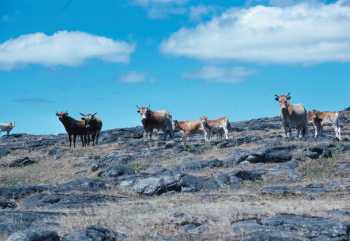According to information received recently from colleagues in France efforts are continuing to be made to rid the French sub-Antarctic islands in the southern Indian Ocean of some of their introduced mammalian species.
The feral cattle Bos taurus of Ile Amsterdam are no more, the last individuals having been killed in 2010. Cattle were first introduced to the island in 1871, but had been controlled in recent years by shooting and fencing to help conserve the island's endemic Amsterdam Albatross Diomedea amsterdamensis. Being no longer necessary, the fencing was removed in December last year.


Feral cattle on Ile Amsterdam: now eradicated
Photographs by Marc Lebouvier
Nearly all the Mouflon Ovis aries were eradicated from Ile Haute in the Golfe du Morbihan, Kerguelen Islands (the only place they occurred) in 2010, with the last five animals now being actively hunted. Mouflon (from which domestic sheep have descended) were first introduced to Kerguelen in 1956.
Live poultry and domestic sheepdogs are no longer kept at any of the islands and greenhouses are no longer used to grow vegetables on Iles Crozet and Kerguelen. Outside cultivation of vegetables at Ile Amsterdam continues but is strictly controlled. Planting of the indigenous Island Tree Phylica arborea continues on Ile Amsterdam and efforts to eradicate selected alien plants are underway on this island and also on Ile de la Possession, Crozet Islands.
Lastly, biosecurity procedures are in place to reduce the risks of further alien introductions at all the islands on which landings are made.
There still remain a number of introduced mammals on the French sub-Antarctic islands, however, ranging from Reindeer Rangifer tarandus on Grand Terre, Kerguelen to House Mice Mus musculus, rats Rattus spp. and feral cats Felis catus on various (but not all) islands.
Conservation and restoration efforts are supported by the declaration of most of the islands as a national nature reserve (réserve naturelle nationale des Terres australes françaises) in 2006, as a Ramsar Wetland of International Importance in 2008 and by the adoption of a management plan by Terres australes et antarctiques françaises (TAAF) in 2011.
Selected References:
Brodier, S., Pisanu, B., Villers. A., Pettex, E., Lioret, M., Chapuis, J.-L. & Bretagnolle, V. 2011. Responses of seabirds to the rabbit eradication on Ile Verte, sub-Antarctic Kerguelen Archipelago. Animal Conservation 14: 459-465.
Chapuis, J.-L., Boussès, P. & Barnaud, G. 1994. Alien mammals, impact and management in the French subantarctic islands. Biological Conservation 64: 97-104.
Chapuis, J-L., Frenot, Y. & Lebouvier, M. 2004. Recovery of native plant communities after eradication of rabbits from the subantarctic Kerguelen Islands, and influence of climate change. Biological Conservation 117: 167-179.
Chapuis, J.-L., Le Roux, V., Asseline, J., Lefèvre, L. & Kerleau, F. 2001. Eradication of rabbits (Oryctolagus cuniculus) by poisoning on three islands of the subantarctic Kerguelen Archipelago. Wildlife Research 28: 323-331.
Convey, P. & Lebouvier, M. 2009. Environmental change and human impacts on terrestrial ecosystems of the sub-Antarctic islands between their discovery and the mid-Twentieth Century. Papers and Proceedings of the Royal Society of Tasmania 143: 33-44.
Cooke, B.D., Chapuis, J.-L., Magnet, V., Lucas, A. & Kovaliski, J. 2004. Potential use of myxoma virus and rabbit haemorrhagic disease virus to control feral rabbits in the Kerguelen Archipelago. Wildlife Research 31: 415 - 420.
De Villiers, M.S., Cooper, J., Carmichael, N., Glass, J.P., Liddle, G.M., McIvor, E., Micol, T. & Roberts, A. 2006. Conservation management at Southern Ocean islands: towards the development of best-practice guidelines. Polarforschung 75: 113-131.
Duriez, O., Jornvaal, H. & Shirihai, H. 2005. Birds and wildlife of the French sub-Antarctic islands: Crozet, Kerguelen and Amsterdam & St Paul. Dutch Birding 27: 87-115.
Frenot, Y., Chown, S.L., Whinam, J., Selkirk, P.M., Convey, P., Skotnicki, M. & Bergstrom, D.L. 2005. Biological invasions in the Antarctic: extent, impacts and implications. Biological Reviews 80: 45-72.
Frenot, Y., Gloaguen, J.-C., Massé, L. & Lebouvier, M. 2001. Human activities, ecosystem disturbance and plant invasions in subantarctic Crozet, Kerguelen and Amsterdam Islands. Biological Conservation 101: 33-50.
Headland, R.K. 2011. History of exotic terrestrial mammals in Antarctic regions. Polar Record DOI: 10.1017/S0032247411000118.
Jouventin, P., Bried, J. & Micol, T. 2005. Insular bird populations can be saved from rats: a long-term experimental study of white-chinned petrels Procellaria aequinoctialis on Ile de la Possession (Crozet archipelago). Polar Biology 26: 371-378.
Kaeuffer, R., Bonenfant, C., Chapuis, J.-L. & Devillard, S. 2010. Dynamics of an introduced population of mouflon Ovis aries on the sub-Antarctic archipelago of Kerguelen. Ecography 33: 435-442.
Lebouvier, M. & Frenot, Y. 2007. Conservation and management in the French sub-Antarctic islands and surrounding seas. Papers and Proceedings of the Royal Society of Tasmania 14: 23-28.
Micol, T. & Jouventin, P. 1995. Restoration of Amsterdam Island, South Indian Ocean, following control of feral cattle. Biological Conservation 73: 199-206.
Micol, T. & Jouventin, P. 2002. Eradication of rats and rabbits from Saint-Paul Island, French Southern Territories. In: Veitch, C.R. & Clout, M.N. (Eds). Turning the Tide: the Eradication of Invasive Species. Gland: IUCN SSC Invasive Species Specialist Group. pp. 192-205.
Ministère de l'Écologie et du Développement Durable 2008. Décret No. 2006-1211 du 3 octobre 2006 portant creation de la reserve naturelle des Terres australes françaises. Journal Officiel de la République Française. 4 octobre 2006. 4 pp.
Pisanu, B., Caut, S., Gutjahr S., Vernon, P. & Chapuis, J.-L. 2011. Introduced black rats (Rattus rattus) on Ile de la Possession (Iles Crozet, Subantarctic) : diet and trophic position in food webs. Polar Biology 34: 169-180.
TAAF 2006. Instructions sur la protection de l'environnement dans les Terres australes antarctiques françaises. Saint-Pierre: Terres australes et antarctiques françaises. 9 pp.
TAAF 2010. Plan de gestion 2011 - 2015 Réserve naturelle des Terres australes françaises. Saint Pierre, La Réunion: Terres australes et antarctiques françaises. 35 pp.
With thanks to Axel Falguier, Marc Lebouvier and Henri Weimerskirch for information, publications and photographs.
John Cooper, ACAP Information Officer, 22 January 2012
[moo-cow: female domestic cattle Bos taurus, a child's term]

 English
English  Français
Français  Español
Español